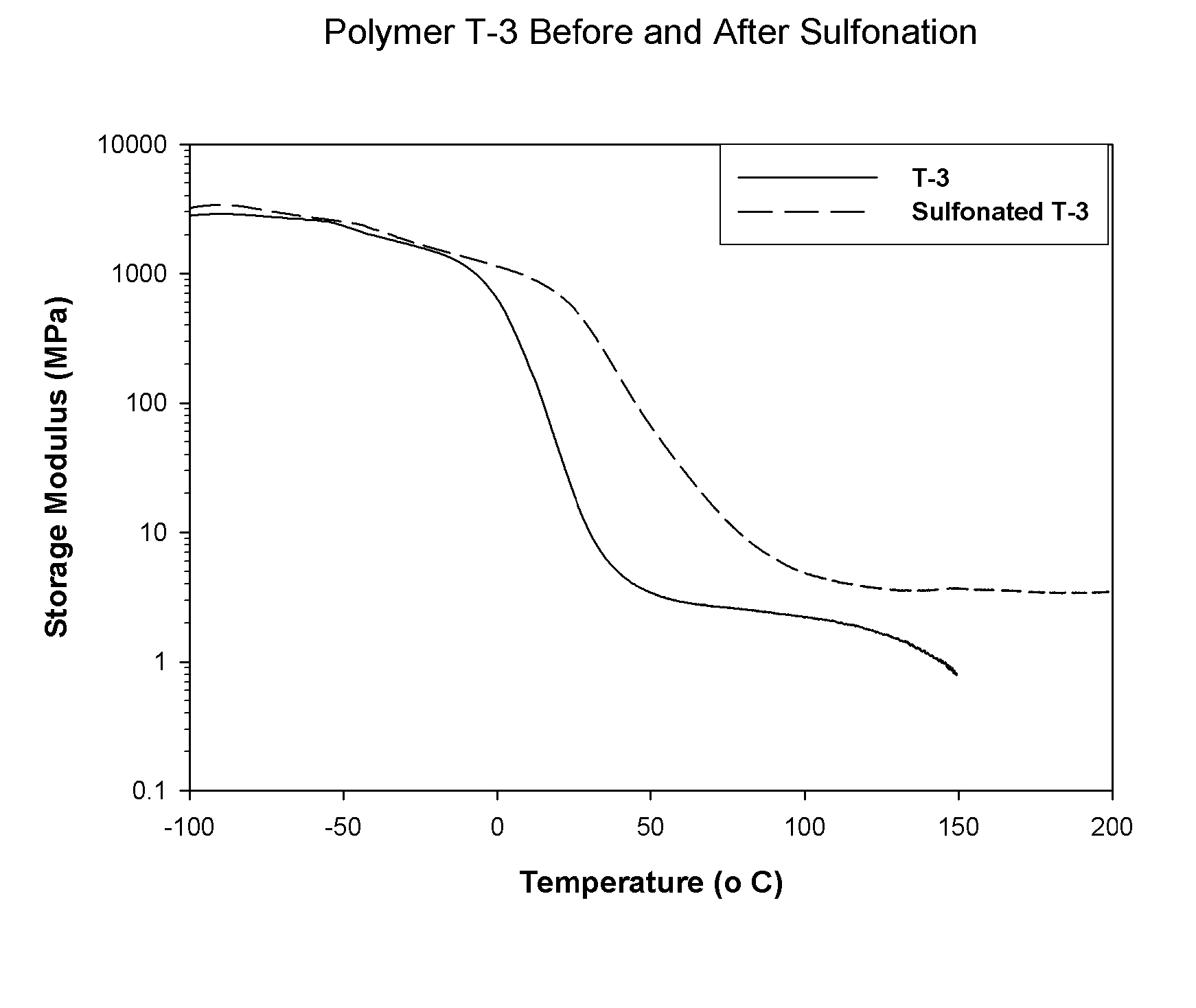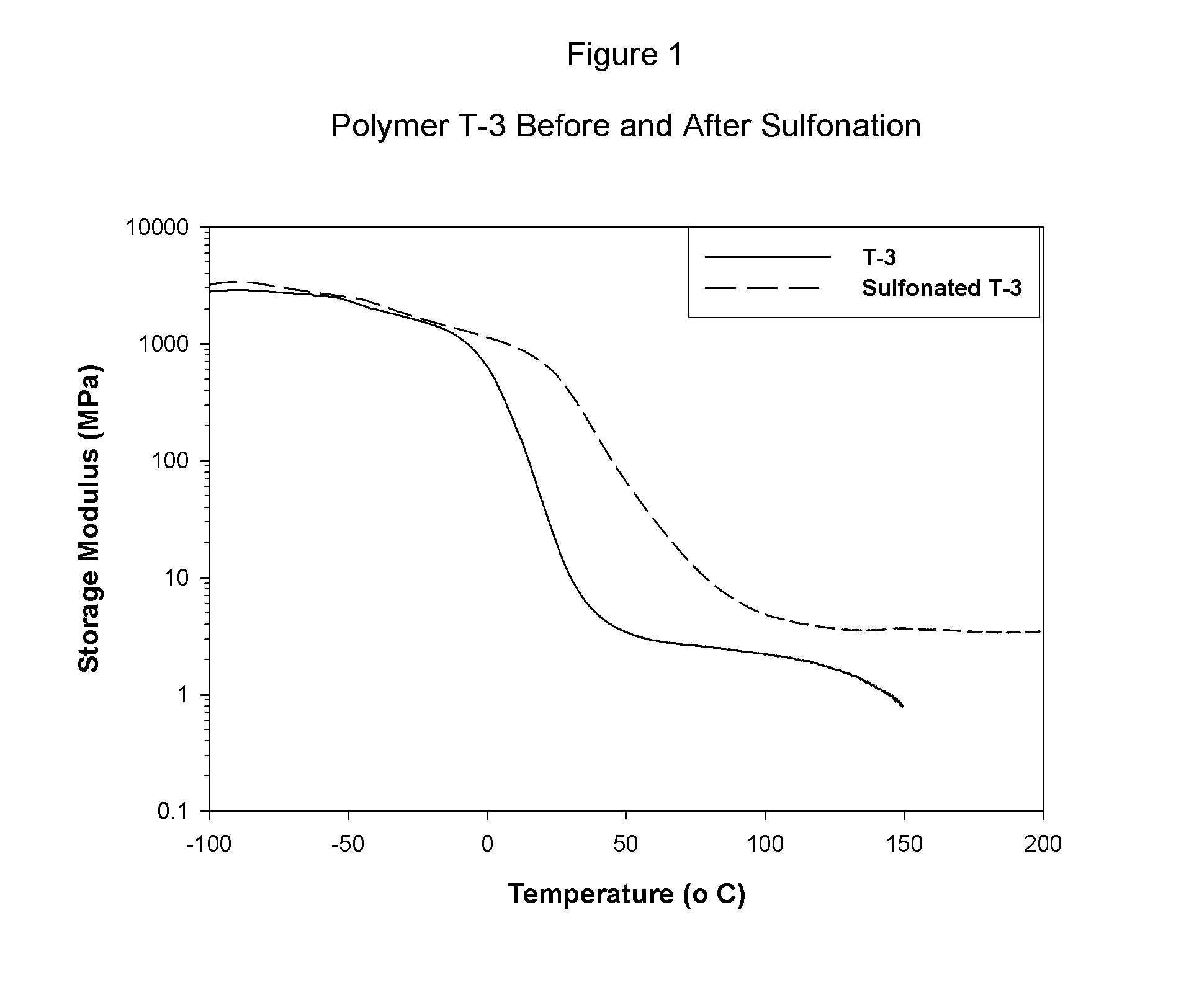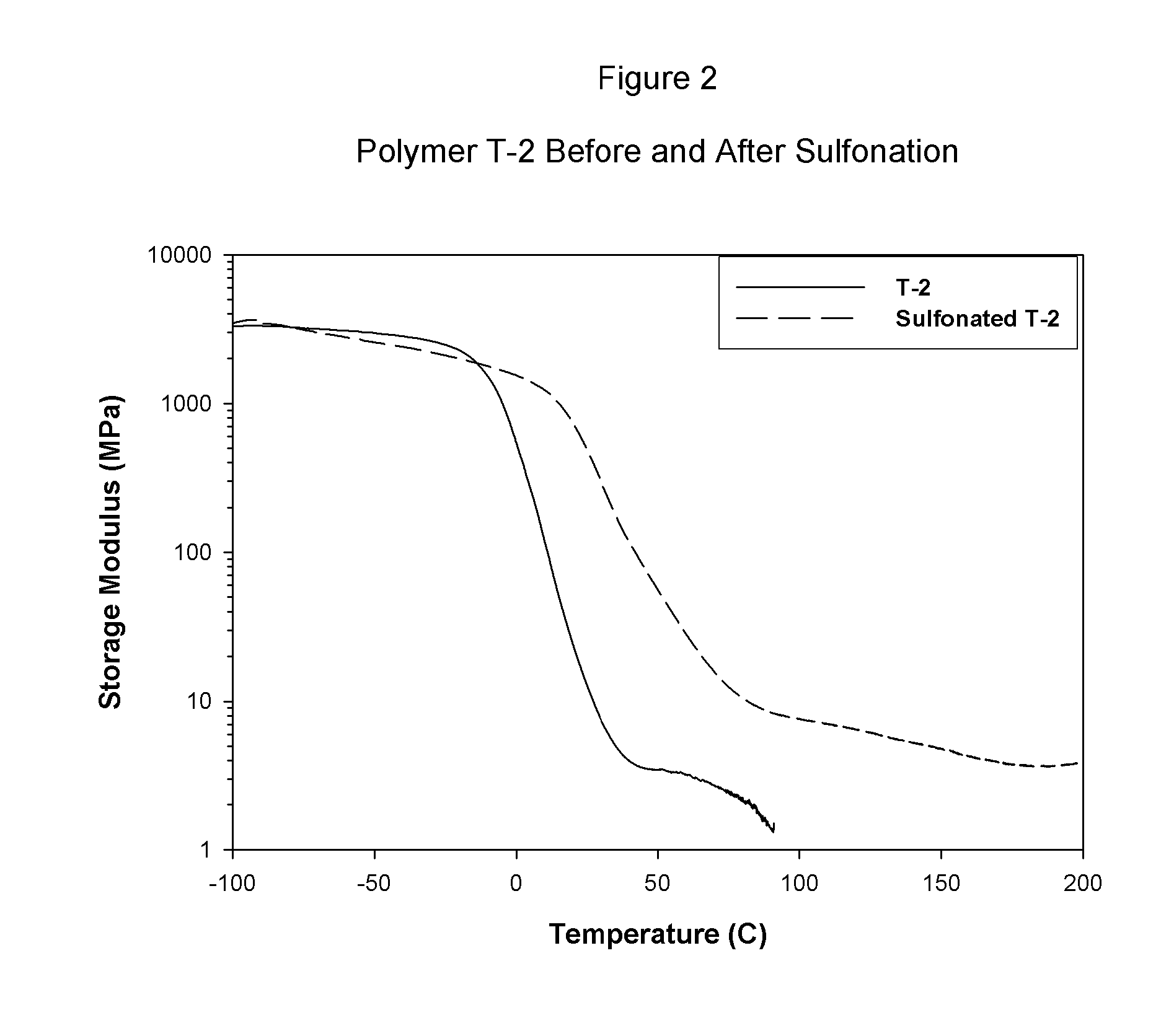[0014] It has now surprisingly been discovered that it is possible to achieve high
water transport properties while maintaining sufficient
wet strength for a wide variety of applications by using sulfonated block copolymers having one or more internal blocks that are susceptible to sulfonation and outer blocks that are resistant to sulfonation. These sulfonated saturated block copolymers of the present invention exhibit a balance of properties, including
water transport,
wet strength, dimensional stability and processability that have heretofore been unachievable. It has been discovered that when sulfonation is limited to one or more internal block(s) of the block
copolymer, hydrophobicity of the outer blocks is retained, and hence their integrity in the presence of a hydrated center or rubber phase. The means by which sulfonation would be directed selectively to the internal or interior block is by, for example, the use of para substituted styrenic monomers such as para-tert-butylstyrene in the outer blocks. The large
alkyl substituent at the para-position on the styrene ring reduces the reactivity of the ring towards sulfonation, thereby directing the sulfonation to one or more of the internal or interior block(s) of the polymer.
[0016] A distinguishing feature of the block copolymers of the present invention which have been selectively sulfonated in an interior block is that they can be formed into objects having a useful balance of properties that have heretofore been unachievable, including strength even when equilibrated with water,
water vapor transport behavior, dimensional stability, and processability. The hydrophobic blocks and their position at the ends of the block
copolymer chain contribute to the
wet strength, dimensional stability and processability of these polymers and objects formed from them. The sulfonated block(s) positioned in the interior of the copolymer allow effective
water vapor transport. The combined properties afford a unique material. As a result of the above, the sulfonated block copolymers of the present invention are capable of being utilized more effectively in a wide variety of uses in which the prior art sulfonated polymers proved deficient due to the
weakness of such polymers in water. Note that sulfonated block copolymers that are “
water soluble” or “water dispersed” by their nature would not have sufficient tensile strength for the applications disclosed herein.
[0099] In still another aspect, the present invention comprises an article formed at least in part from a composition comprising the inventive sulfonated block copolymer. In particular, the present invention contemplates articles, such as, for example,
fuel cells,
proton exchange membranes for
fuel cells, dispersions of
metal impregnated carbon particles in
sulfonated polymer cement for use in an
electrode assemblies, including
electrode assemblies for
fuel cells, fabrics, coated fabrics, surgical supplies and devices,
filtration membranes,
air conditioning membranes, heat
recovery membranes,
desalination membranes, adhesives,
personal hygiene articles,
super absorbent articles, binders for super absorbents and antifouling coatings. Specific examples of such articles include, but are not limited to, selective, permeability membranes formed in part from a composition comprising the sulfonated block copolymer. Other uses include fibers, tubes, fabrics, sheets, coatings for woven and non-woven fabrics and laminates. Specific applications include, but are not limited to, breathable protective clothing and gloves for first responders, firefighters, chemical and biological workers, agricultural workers, medical employees, and military personnel involved in handling potentially hazardous materials; sports and recreational clothing; tenting; selective membranes for industrial, medical and water purification applications; and systems which avoid
moisture build up inside the walls and between the floor and foundation of a house. Other specific applications are in
personal hygiene, including use as super absorbents or binders for super absorbents in diapers or incontinence products. Still other specific applications include
marine coatings and anti-
fouling coatings in general. Yet other applications include coatings for membranes, such as coatings on
polysulfone desalination membranes.
[0105] Without wishing to be bound to a particular theory, the inventors believe that the significance of the present invention depends upon two structural features of the block copolymers: 1) the striking polarity differences between the outer A blocks and the interior B blocks regulate the
physics a) of phase separation of the blocks of the copolymers, b) of water transportation through the membranes, and c) of the barrier properties of these polymers to species other than water and protons; and 2) the strength and dimensional stability of materials prepared from these polymers depends on the A blocks having no or very little functionality. The polarity of the B interior blocks derives from the sulfonation of the vinyl aromatic moieties enchained in the B interior block segments(s). In the
solid phase, these aromatic
sulfonic acid species (—SO3H centers)
self assemble into a continuous, polar phase that is extremely hydrophilic. This phase affords a ready pathway for protons or water to pass from one side of the membrane to the other. The greater is the density of —SO3H sites in this phase (mol of —SO3H / g of block copolymer), the faster is the transport of water molecules through the
composite material. These pathways might be thought of as microphase separated
ion or water channels that are approximately ten to a few thousand angstroms wide. In this multi-phase material, these channels are constrained by a non-polar, hydrophobic phase, which is composed of the hydrophobic A blocks of the copolymer. As the A blocks contain no or very few reactive centers, following sulfonation the A blocks have no or very little sulfonic acid functionality. As a result and in contrast to the B interior blocks, the A blocks are very resistant to
permeation by water or protonic species. The properties of the A block phase of the multi-phasic material are not readily affected by the addition of protonic materials or water. For this reason, the non-polar A block phase of the copolymer material is not significantly weakened by the addition of water. By example with regard to one embodiment of the present invention, as each B interior block is chemically attached to two A block outer segments, the composite, multiphasic material has substantial strength in the wet state, as well. In fact, a comparison of the strength of a film or membrane prepared from a selectively sulfonated block copolymer tested while wet versus its strength when tested while dry is a good measure of the absence (or near absence) of functionality in the A block of the copolymer; the wet strength should be at least more than 30% of the strength of the dry sample.
[0109] Block copolymers having sulfonation resistant outer segments, A blocks, and sulfonation susceptible interior segments, saturated B blocks, may be selectively sulfonated to afford materials having a unique two-phase structure. A consequence of this structure is that non-
crosslinked polymers having a unique balance of useful properties—good dimensional stability, surprising
water transport rates, and surprising strength in the presence of water—may be formed. The specific balance of properties needed for a particular application may be tuned by adjusting the nature or dimensions of the A and B blocks of the copolymer, the level of sulfonation of the polymer, the
linearity or degree of branching in the starting polymer before sulfonation, and the amount of
neutralization, if any, of the —SO3H sites. The need for materials having these types of properties is great. Myriad applications for films, membranes, fibers to include non-woven fibers, coatings, adhesives, molded articles and the like have been identified. The use of these articles to provide protection against chemical and biological agents, to purify aqueous streams, to guard against fungal and microbial growth, to allow evaporative cooling by transport of water (particularly from sweating) to a surface, to enhance the absorption of
radiant energy when wet, and to soak up water are envisioned. The breadth of utility of this invention therefore appears to be large.
 Login to View More
Login to View More 


